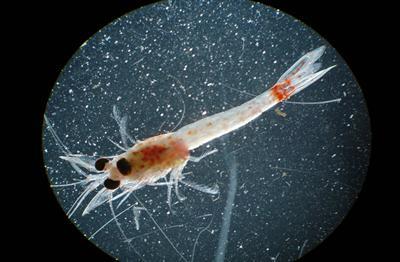 MADISON, Wisc.—A single specimen
of the bloody red shrimp (Hemimysis anomala) has been detected in the Lower St.
Louis River near Allouez Bay, Wisconsin, the Wisconsin Department of Natural
Resources (WDNR) and the U.S. Fish and Wildlife Service (Service) announced
today. Sweep net samples were processed and taxonomic identification
completed by Service staff and Badger Technical Services in January
2018.[WRS-D1] This is the first detection of the species in Lake
Superior, which was collected as part of annual sampling done by the Service.
MADISON, Wisc.—A single specimen
of the bloody red shrimp (Hemimysis anomala) has been detected in the Lower St.
Louis River near Allouez Bay, Wisconsin, the Wisconsin Department of Natural
Resources (WDNR) and the U.S. Fish and Wildlife Service (Service) announced
today. Sweep net samples were processed and taxonomic identification
completed by Service staff and Badger Technical Services in January
2018.[WRS-D1] This is the first detection of the species in Lake
Superior, which was collected as part of annual sampling done by the Service.“While the collection of a single individual shrimp suggests this species is not abundant or widespread, it’s a disappointing detection. While the impacts on other Great Lakes are currently unknown, we still want to be cautious about how we approach the management of this species,” said Jeremy Bates, Early Detection and Rapid Response Coordinator with the WDNR.
Bloody red shrimp was first reported in 2006 in Lake Ontario and Lake Michigan, and is already documented in all other Great Lakes. The species, like other invasive species, are known to reproduce and spread, ultimately degrading habitat, out-competing native species and short-circuiting food webs.
“Early detection is crucial to effectively managing invasive animals before they gain a foothold in the environment,” said Amy McGovern, Midwest Aquatic Nuisance Species Coordinator for the U.S. Fish and Wildlife Service. “The discovery of a bloody red shrimp in Lake Superior is a testament to the ongoing importance of the Great Lakes Early Detection and Monitoring Program.”
The Service will continue targeted sampling for bloody red shrimp and other annual AIS sampling throughout the Great Lakes as part of the Great Lakes Early Detection and Monitoring Program.
Boaters and anglers in Wisconsin are asked to do their part to make sure aquatic invasive species (AIS) don’t move to inland waters by taking the following preventive measures:
- Inspect
and thoroughly clean equipment and clothing
- Remove
aquatic plants and debris from boats and equipment
- Drain
water from live wells and bilge compartments before leaving the waterway
- Transport
your catch on ice
No comments:
Post a Comment